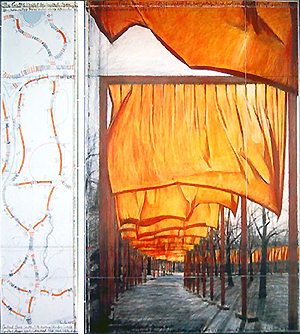I'm still reeling a bit from this past weekend's conference. Some of the more choice juxtapositions between the two forces (mostly paraphrased, not exact):
"It is a shame that Jane Jacobs' work has disconnected the study of cities from cities...she has created an era of hyper-nostalgia which gets in the way of progress." -- Rem Koolhaas
"Jane Jacobs was the first real brave attempt to understand how cities work." -- Michael Sorkin
Or, how about these:
"Communities get in the way of the future, especially for architecture." -- unknown architect
"Neighborhoods prevent the imagination of architecture," Harvard professor of Architecture." -- Hashim Sarkis
vs.
"Neighborhoods are what matter most to New Yorkers, when we ask, and that is what we are trying to keep." -- Amanda Burden (for whom, I have to say, my respect grew), and
"Maybe architecture is about designing for delight, not for the potential gloom." -- Harvey Molotch
Or, how about this final coup de grace,
"Public participation is what prevents city government from getting anything done," Esther Fuchs
vs.
"Community organizing is the only way that we now have city planning trying to come up with innovative solutions." -- Ron Schiffman
Yikes. It was a ping pong game and there was no diplomacy (someone suggested that actually, there was incredible amounts of diplomacy, since there were no physical fistfights.) The New York session is the first conference of a series of six to be held around the country, and at best, it delineated for the group of urban experts the work ahead. Some of the stark differences highlighted include those between theory and practice; between city managers and community organizers; between architecture and planners; between academics and practitioners. Of course, these are the most obvious contrasts, why should this be any different? Certainly, it was a unique conference in that so many influential individuals actually tried to discuss the same topic, but in the end, what they said was not the same topic at all, but just talking past each other.
Yes, a room full of experts showed that cities are complex organisms. In fact, if you think about your favorite places, the places that make up what you might determine is a great city, you realize that it is very difficult to say what exactly makes it so great. Is it the pedestrians and bicyclists? Is it that there is a diverse group of people walking about? Is it the sidewalk, the retail mix, the housing stock, the safety, the proximity to transit, the nearness of amenities, the nearness to open space...the list can go on and on.
So when a group tries to talk about re-creating great cities, or building their cities for greatness, it is as hard to replicate as it is to replicate a human being. You can do it - clone the DNA, get all the right inputs - but you might miss the heart and soul and vibrancy. It is just too hard to try to re-create something as complex as a great place from scratch. That's why it's important to start creating places with people. The multitude of people who will have opinions will get you closer to a great place in a city than anything else.
Perhaps in cities with less attitude (the New York audience did have a chip on its shoulder, but with the "almost right" tagline, who could blame us) discussion might be more fruitful. As Tony Travers optimistically said, "If we can do it in New York, we can do it anywhere." Good luck.








































